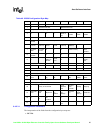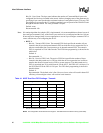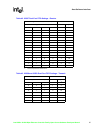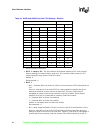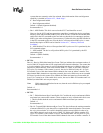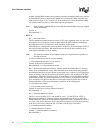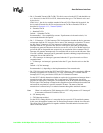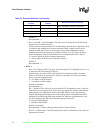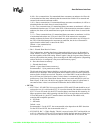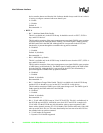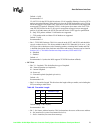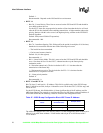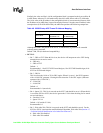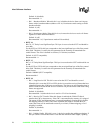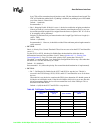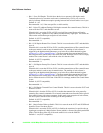
Intel 8255x 10/100 Mbps Ethernet Controller Family Open Source Software Developer Manual 73
Host Software Interface
0 (00) = No re-transmission. If a transmitted frame encounters an underrun it will not be
re-transmitted and the status indicating that the transmission failed will be returned and
counted in the transmit underrun counter.
1 (01) = One re-transmission. If a transmitted frame encounters an underrun, it will be re-
transmitted after the whole frame is stored in the FIFO.
2 (10) = Two re-transmissions. If a transmitted frame encounters an underrun it will be re-
transmitted when there are 512 bytes in the FIFO. If the transmission encounters another
underrun, the frame will be transmitted once again when the whole frame is stored in the
FIFO.
3 (11) = Three re-transmissions. If a transmitted frame encounters an underrun, it will be
re-transmitted when there are 512 bytes in the FIFO. If the transmission encounters
another underrun, the frame will be transmitted once again when there are 1024 bytes in
the FIFO. If the third attempt also encounters an underrun, the device will transmit it
again when the whole frame is stored in the FIFO.
Default - 0 (no retransmission).
Recommended - 1.
— Bit 0 - Discard Short Receive Frames.
This bit determines whether short frames (shorter than 64 bytes) are to be discarded or
saved. When it is set to 1, the device internally discards frames shorter than 64 bytes on
the link regardless of the SBF setting. When it equals 0, the device passes these frames to
memory and reclaims the memory space according to the SBF configuration. (Depending
on how the device is configured, it may not reclaim memory space.)
0 = Pass short frames to memory.
1 = Discard short frames.
Default - 0 (pass short frames to memory).
Recommended - 1 (0 in promiscuous mode).
The discard short frames feature should we used with caution when it is combined with
header receive interrupts. If the discard short frames feature is used, no data is passed to
memory before 64 bytes are received. Therefore, even if the HDS is set to less than 64, the
device will not pass a bad receive status if a short frame is encountered. However, a
problem may occur if the discard short frames feature is not used and HDS is set to less
than 64 bytes. In this case, the device may report a bad receive status if a short frame is
encountered since it does not reclaim an RFD that has had its HDS field filled.
• BYTE 8.
— 82557: Bit 0 - 503/MII. This bit is reserved on the 82558 and 82559 and should be set to 1
on those devices. It is valid on the 82557. It is used to select the link interface mode of the
82557. If set to 503 mode (0), the 82557 transfers data to and from the link assuming 10
Mbps operation as done when operating with the 82503 or an equivalent serial interface.
If set to MII mode (1), the 82557 transfers data to and from the link nibble-wide,
assuming MII compatible operation.
0 = 503 mode.
1 = MII mode.
Default - none.
Recommended - For the 82557, the recommended value depends on the PHY detection.
For the 82558 and 82559, the recommended value is 1.
— 82558/82559: Bit 7 - CSMA Disable. This bit is reserved on the 82557 and should be set
to 0. It is valid on the 82558 or 82559 and used to disable the link operation of the device.
If it is set to 1, the device will not receive data to or from the link. If it is set to 0, the



